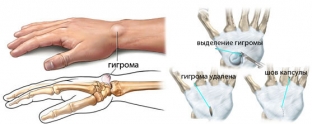On the fingers, wrists, legs in the area of the joints, growths or bumps may appear, which are not malignant in nature and are called hygroma (synovial cyst). These bumps can cause discomfort, hurt or not manifest themselves in any way. This disease is often called occupational; pianists, tennis players, computer workers, laundresses suffer from it. Consider on estet-portal.com how to get rid of bumps on the fingers and what are the advantages of the surgical method of treatment.
What is a hygroma: a cyst or a lump?
Three names of the same concept characterize the growth on the joint in the synovial bag, in which fluid accumulates with mucus. This liquid is in a capsule – ganglia. The neoplasm can grow and reach 0.5 or 3 cm in diameter.
Most often, hygroma is formed on the fingers or wrists, although it can be located on the palms or on the back of the hand. Also, the cyst can affect one or all fingers on the hands, approaching the nail, affecting the plate. The color of the hygroma depends on age and fullness and can be pink, transparent or skin-colored.
A synovial cyst can be painful and uncomfortable for the wearer, and can expand, grow, and multiply. Also, a cyst may not cause inconvenience to the patient, a person lives with it all his life and does not pay any attention to this formation without any questions, how to get rid of bumps on the fingers or in other places.
Causes of hygroma and diagnosis
The underlying cause of the cyst is unknown in most cases. In some patients with hygroma – this is a consequence of damage to the joints with bursitis or arthritis. In other people, growths appear due to constant physical exertion on this place, for example, while writing – on the finger, while playing a musical instrument (not only the piano), if you constantly work at the computer – on the wrist. Also, a bump on the leg appears due to the constant wearing of tight and uncomfortable shoes. Moreover, there are cases when a hygroma appears for no particular reason, quite possibly under the influence of a genetic predisposition. It is believed that bumps on the fingers, wrists or feet appear in men more often than in women.
Doctors do not always recommend removing hygroma. If the cyst does not disturb the patient, there is no pain and discomfort, the nail plate is not deformed – treatment is not required. It is necessary to observe the size of the cone and monitor the fullness and color. In case of pain, fluid leakage, growth or discoloration, surgical excision of the ganglion is prescribed.
Doctors warn that this disease cannot be self-treated. If the hygroma is crushed, several formations filled with serous-mucous or serous-fibrinous fluid will appear in its place.

How to get rid of bumps on the fingers: the benefits of surgery
Among the many methods of treatment, hygroma can only be surgically removed, other mechanisms cannot ensure complete recovery. Hygroma puncture is not recommended due to relapse and infection in the joint. This method ensures that the liquid is removed, while the stem itself remains, and a new bump will not keep you waiting.
If the cyst hurts and it remains only to decide how to get rid of bumps on the fingers, doctors advise to perform an operation to excise the hygroma rod – bursectomy. This is a planned operation, requiring a preliminary diagnosis of the patient. Laboratory tests of urine and blood are prescribed, as well as a study for the presence of hepatitis, HIV infection and syphilis.
The operation does not take much time and is performed under local anesthesia. To remove the hygroma core from soft tissues, it will take from 15 minutes to 1 hour, depending on the experience of the doctor and the complexity of the operation. A few hours after the operation, the patient can leave the hospital and go home. The only thing that will need to be done is to remove the stitches after 10-14 days. After surgery, the joint remains intact, only the lump is removed.
If the hygroma is accompanied by complications and an infection joins, the operation is performed under general anesthesia and the patient needs to stay in the hospital until all life-threatening symptoms disappear.
Patients often ask related questions to their doctor: how to diagnose hygroma, how to get rid of bumps on fingers or wrists, and others. Experienced surgeons answer that the best way to remove the bump is to excise the hygroma.






Add a comment